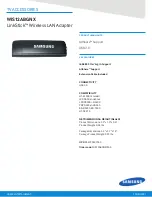
User’s Guide
21020285 D
Chapter 2 Hardware Essentials
Hardware Structure and Description
Page 2 - 3
Hardware
Structure and
Description
The RF3880 hardware design incorporates the technology available from the
following components:
•
Intel 20 MHz 80186XL microprocessor
•
QLogic FAS256 16-bit, Fast SCSI Controller chip
•
High Density Programmable Logic Devices (PLD’s) for VMEbus, and
buffer control
•
Ciprico Pipelined System Interface (PSI)
Intel 80186XL
At the core of the RF3880 design is the 80186XL supervisory microprocessor.
The 80186 is well suited to the task of overseeing board operations; it uses
optimized instruction encoding for high performance and memory efficiency.
RF3880 performance is further boosted by using the 20 MHz version of the
80186.
QLogic
FAS 256
SCSI bus protocol for the RF3880 is efficiently handled by the QLogic Fast
SCSI chip. The QLogic chip provides the capability for 16-bit transfers on the
SCSI bus, as well as negotiation for Fast Synchronous transfers across the bus,
up to 20 MB/s. The QLogic FAS256 chip is a registered device that can be set-
up for automated bus operations. These options are available to you via the
Board-control commands discussed in Chapter 7.
Pipelined
System
Interface
Ciprico created the custom VLSI Pipelined System Interface (PSI) to
coordinate access to the system address bus; it has registers for the DMA
address count and transfer count. Also contained in the chip are the Channel
Attention port register and the Interrupt Request level register.
Data Buffer
Using high-speed video DRAMs to provide 512 Kbytes of buffer space with
hardware control logic, the RF3880 creates a data buffer that adjusts
dynamically to the type and size of the data transfers involved. Performed in
hardware, this design maximizes performance by bypassing the need for
microprocessor involvement.
Summary of Contents for Rimfire 3880
Page 1: ...Rimfire 3880 SCSI Host Bus Adapter User s Guide Ciprico Inc Publication No 21020285 D...
Page 2: ......
Page 4: ...21020285 D User s Guide...
Page 25: ...2 H a r d w a r e E s s e n t i a l s...
Page 42: ...21020285 D User s Guide Chapter 2 Hardware Essentials Page 2 18 Descriptions of Port Usage...
Page 43: ...3 H a r d w a r e I n s t a l l a t i o n...
Page 59: ...4 C o m m a n d O p e r a t i o n...
Page 85: ...5 I n i t i a t o r M o d e P a s s t h r o u g h C o m m a n d s...
Page 103: ...6 T a r g e t M o d e P a s s t h r o u g h C o m m a n d s...
Page 125: ...7 B o a r d c o n t r o l C o m m a n d s...
Page 175: ...8 D e t a i l s o f U s a g e...
Page 193: ...A E r r o r C o d e s...
Page 201: ...B C a b l e s a n d C o n n e c t o r s...
Page 206: ...21020285 D User s Guide Appendix B Cables and Connectors Page B 6 VMEbus Connector Pinouts...
Page 207: ...C S p e c i f i c a t i o n s...
Page 210: ...21020285 D User s Guide Appendix C Specifications Page C 4 Specifications...
Page 211: ...D D e f a u l t s...
Page 216: ...21020285 D User s Guide Appendix D Defaults Page D 6 HardwareDefaults...
Page 217: ...E D e s i g n D i f f e r e n c e s...
Page 229: ......
Page 230: ...21020285 D...
















































